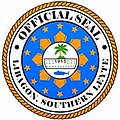Libagon | |
|---|---|
| Municipality of Libagon | |
 Rizal Park of Libagon | |
 Map of Southern Leyte with Libagon highlighted | |
 Interactive map of Libagon | |
Location within the Philippines | |
| Coordinates: 10°18′N125°03′E / 10.3°N 125.05°E | |
| Country | Philippines |
| Region | Eastern Visayas |
| Province | Southern Leyte |
| District | 2nd district |
| Founded | 1913 |
| Barangays | 14 (see Barangays) |
| Government | |
| • Type | Sangguniang Bayan |
| • Mayor | Sabina B. Ranque (PDPLBN) |
| • Vice Mayor | Elizabeth L. Saldivar (PDPLBN) |
| • Representative | Christopherson M. Yap |
| • Municipal Council | Members |
| • Electorate | 11,008 voters (2025) |
| Area | |
• Total | 98.62 km2 (38.08 sq mi) |
| Elevation | 150 m (490 ft) |
| Highest elevation | 887 m (2,910 ft) |
| Lowest elevation | 0 m (0 ft) |
| Population (2024 census) [3] | |
• Total | 16,146 |
| • Density | 163.7/km2 (424.0/sq mi) |
| • Households | 3,560 |
| Economy | |
| • Income class | 5th municipal income class |
| • Poverty incidence | 26.31 |
| • Revenue | ₱ 139.6 million (2022) |
| • Assets | ₱ 412.1 million (2022) |
| • Expenditure | ₱ 125.2 million (2022) |
| • Liabilities | ₱ 103.9 million (2022) |
| Service provider | |
| • Electricity | Southern Leyte Electric Cooperative (SOLECO) |
| Time zone | UTC+8 (PST) |
| ZIP code | 6615 |
| PSGC | |
| IDD : area code | +63 (0)53 |
| Native languages | Boholano dialect Cebuano Tagalog |
| Website | www |
Libagon (Cebuano : Lungsod sa Libagon; Tagalog : Bayan ng Libagon) is a municipality in the province of Southern Leyte, Philippines. According to the 2024 census, it has a population of 16,146 people. [5] [6]
Contents
- Etymology
- History
- Geography
- Barangays
- Climate
- Demographics
- Language
- Religion
- Economy
- Culture
- Feasts
- The Parish of the Immaculate Conception
- Government
- List of former chief executives
- Notable sites
- Patag Daku Rainforest
- Municipal Town Hall
- Old Seaport and Rizal Park
- Education
- The Parish Convent and Libagon Academy
- Infrastructure
- Transportation
- References
- External links
Every July 16 and December 8, Libagon celebrates two town festivals: the Feast of Our Lady of Mount Carmel [7] and the Feast of the Immaculate Conception. [8]
The main sources of income for Libagon residents include copra, abacá, agriculture, and fishing.




